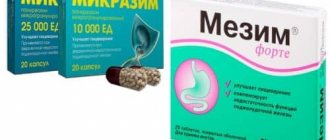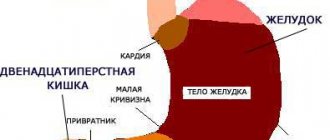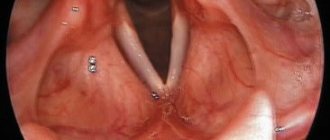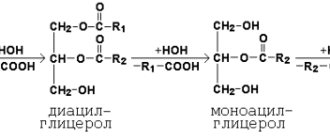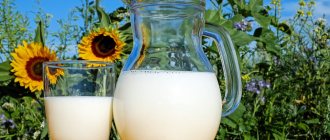Digestion in the oral cavity. The oral cavity is the anterior initial section of the digestive apparatus. With the help of teeth, tongue and cheek muscles, food undergoes initial mechanical processing, and with the help of saliva - chemical processing.
Saliva is a slightly alkaline digestive juice produced by three pairs of salivary glands (parotid, sublingual, submandibular) and entering the oral cavity through ducts. In addition, saliva is secreted by the glands of the mucous membrane of the lips, cheeks and tongue. In just a day, about 1 liter of saliva of different consistencies is produced: thick saliva is secreted for digesting liquid food, liquid saliva is secreted for dry food. Saliva contains the enzyme amylase or ptyalin, which breaks down starch into maltose, the enzyme maltose, which breaks down maltose into glucose, and the enzyme lysozyme, which has an antimicrobial effect.
Food remains in the oral cavity for a relatively short time (10-25 s). Digestion in the mouth consists mainly of the formation of a bolus of food prepared for swallowing. The chemical effect of saliva on food substances in the oral cavity is negligible due to the short residence of food. Its action continues in the stomach until the bolus of food is completely saturated with acidic gastric juice. However, processing food in the mouth is of great importance for the further progress of the digestive process, since the act of eating is a powerful reflex stimulator of the activity of all digestive organs. The bolus of food, with the help of coordinated movements of the tongue and cheeks, moves towards the pharynx, where the act of swallowing occurs. From the mouth, food enters the esophagus.
The esophagus is a muscular tube 25-30 cm long, through which, due to muscle contraction, the food bolus moves to the stomach in 1-9 seconds, depending on the consistency of the food.
Digestion of food in the stomach. The stomach, the widest part of the digestive tract, is a hollow organ consisting of an inlet, a fundus, a body and an outlet. The inlet and outlet openings are closed with a muscle roller (pulp). The stomach capacity of an adult is about 2 liters, but can increase to 5 liters. The inner mucous membrane of the stomach is folded, which increases its surface area. In the thickness of the mucous membrane there are up to 25,000,000 glands that produce gastric juice and mucus. Gastric juice is a colorless acidic liquid containing 0.4-0.5% hydrochloric acid, which activates gastric juice enzymes and has a bactericidal effect on microbes that enter the stomach with food. The composition of gastric juice includes enzymes: pepsin, chymosin (rennet), lipase. The enzyme pepsin breaks down food proteins into simpler substances (peptones and albumoses), which are further digested in the small intestines. Chymosin is found in the gastric juice of infants, coagulating milk protein in their ventricles. Gastric juice lipase breaks down only emulsified fats (milk, mayonnaise) into glycerol and fatty acids.
A person secretes 1.5-2.5 liters of gastric juice per day, depending on the amount and composition of food. Food in the stomach is digested from 3 to 10 hours, depending on the composition, volume, consistency and method of its processing. Fatty and dense foods stay in the stomach longer than liquid foods containing carbohydrates.
The mechanism of gastric juice secretion is a complex process consisting of two phases. The first phase of gastric secretion is a conditioned and unconditioned reflex process, depending on the appearance, smell and conditions of food intake. The great Russian scientist-physiologist I.P. Pavlov called this gastric juice “appetizing” or “ignition”, on which the further course of digestion depends. The second phase of gastric secretion is associated with chemical pathogens of food and is called neurochemical. The mechanism of gastric juice secretion also depends on the action of specific hormones of the digestive organs. Partial absorption of water and mineral salts occurs in the stomach. After digestion in the stomach, the food pulp enters in small portions into the initial section of the small intestines - the duodenum, where the food mass is actively exposed to the digestive juices of the pancreas, liver and the mucous membrane of the intestine itself.
The role of the pancreas in the process of digestion . The pancreas is a digestive organ consisting of cells that form lobules that have excretory ducts that connect to form a common duct. Through this duct, the digestive juice of the pancreas enters the duodenum (up to 0.8 liters per day). Digestive juice of the pancreas is a colorless transparent liquid of an alkaline reaction. It contains enzymes: trypsin, chymotrypsin, lipase, amylase, maltose. Trypsin and chymotrypsin break down proteins, peptones, albumoses coming from the stomach into polypeptides. Lipase, with the help of bile, breaks down food fats into glycerol and fatty acids. Amylase and maltose break down starch into glucose. In addition, the pancreas has special cells (islets of Langerhans) that produce the hormone insulin that enters the blood. This hormone regulates carbohydrate metabolism, facilitating the absorption of sugar by the body. In the absence of insulin, diabetes mellitus occurs.
The role of the liver in the digestive process . The liver is a large gland weighing up to 1.5-2 kg, consisting of cells that produce bile up to 1 liter per day. Bile is a light yellow liquid with a slightly alkaline reaction. It activates the enzyme lipase of pancreatic and intestinal juice, emulsifies fats, promotes the absorption of fatty acids, enhances the movement (peristalsis) of the intestines, and suppresses putrefactive processes in the intestines. Bile from the hepatic ducts enters the gallbladder - a thin-walled pear-shaped sac with a capacity of 60 ml. During the digestion process, bile flows from the gallbladder through the duct into the duodenum. In addition to the digestion process, the liver is involved in metabolism, hematopoiesis, retention and neutralization of toxic substances that enter the blood as a result of digestion.
Digestion in the small intestines. The length of the small intestines is 6-7 m. The digestion process is completed in them thanks to pancreatic juice, bile and intestinal juice secreted by the glands of the intestinal mucosa (up to 2 liters per day).
Intestinal juice is a cloudy liquid of an alkaline reaction, which contains mucus and enzymes: polypeptidases and dipeptidases, which break down polypeptides into amino acids; lipase, which hydrolyzes fats to glycerol and fatty acids; amylase and maltose, which digest starch into glucose; sucrose, which breaks down sucrose into glucose and fructose; lactose, which hydrolyzes lactose to glucose and galactose.
The main causative agents of intestinal secretory activity are chemicals contained in food, bile and pancreatic juice.
In the small intestines, food gruel (chyme) is mixed and distributed in a thin layer along the wall, where the final process of digestion occurs - the absorption of the products of breakdown of nutrients, as well as vitamins, minerals, and water into the blood. Here, aqueous solutions of nutrients formed as a result of digestion penetrate through the mucous membrane of the gastrointestinal tract into the blood and lymphatic vessels.
In the walls of the small intestine there are special absorption organs - villi, of which there are 18-40 pieces. per 1 sq. mm. Nutrients are absorbed through the surface layer of villi. Amino acids, glucose, water, minerals, and water-soluble vitamins enter the blood. Glycerol and fatty acids in the walls of the villi form fat droplets characteristic of the human body, which penetrate into the lymph and then into the blood. Blood, freed in the liver from toxic substances of digestion, supplies all tissues and organs with nutrients.
The role of the large intestines in the digestive process. Undigested food remains enter the large intestines. A small number of glands of the large intestine secrete inactive digestive juice, which partially continues the digestion of nutrients. The large intestines contain a large number of bacteria that cause fermentation of carbohydrate residues, rotting of protein residues and partial breakdown of fiber. In this case, a number of toxic substances harmful to the body are formed (indole, skatole, phenol, cresol), which are absorbed into the blood and then neutralized in the liver.
The composition of colon bacteria depends on the composition of the incoming food. Thus, dairy-vegetable foods create favorable conditions for the development of lactic acid bacteria, and foods rich in protein promote the development of putrefactive microbes. In the large intestines, the bulk of water is absorbed into the blood, as a result of which the intestinal contents become denser and move towards the outlet. Removal of feces from the body is carried out through the rectum and is called defecation.
Biological role and structure of proteins
Proteins are high-molecular nitrogen-containing organic substances, the molecules of which are built from amino acid residues.
All natural proteins consist of a small number of relatively simple structural blocks, represented by monomeric molecules - amino acids, linked to each other in polypeptide chains.
Functions of proteins: 1) Structural:
- in connective tissue – collagen, elastin, keratin
- construction of membranes and formation of the cytoskeleton (integral, semi-integral and surface proteins) – spectrin (surface, the main protein of the cytoskeleton of erythrocytes), glycophorin (integral, fixes spectrin on the surface)
- construction of organelles - ribosomes
2) Enzymatic:
All enzymes are proteins
3) Hormonal:
Regulation and coordination of metabolism in different cells of the body - many hormones, for example, insulin and glucagon.
4) Receptor:
Selective binding of hormones, biologically active substances and mediators on the surface of membranes or inside cells.
5) Transport:
Transfer of substances in the blood - lipoproteins (fat transport), hemoglobin (oxygen transport), transferrin (iron transport) or across membranes - Na+,K+-ATPase (opposite transmembrane transport of sodium and potassium ions), Ca2+-ATPase (pumping calcium ions from cells).
6) Reserve: production and accumulation of ovalbumin in the egg.
7) Nutritional: breast milk proteins, muscle and liver proteins during fasting.
Protective: the presence of immunoglobulins and blood clotting proteins in the blood.
Concept of the cellular metabolic pool of amino acids
Amino acids in the cell constitute a dynamic pool, which is continuously replenished and also continuously consumed.
There are three sources of amino acids to replenish this pool:
- coming from the blood
- breakdown of own intracellular proteins
- synthesis of non-essential amino acids.
The path of further transformation of each amino acid depends on the type and function of the cell, the conditions of its existence and hormonal influences. The range of substances obtained by the cell from amino acids is extremely wide.
The reactions of transformation of amino acids in a cell can be divided into three parts, depending on the reacting group:
- with the participation of an amino group - here we mean the removal of an amino group from an amino acid in one way or another, resulting in a hydrocarbon skeleton remaining,
- along the side chain (radical) - the carbon skeleton is used for the synthesis of glucose, fats, or for the formation of ATP energy,
- on the carboxyl group - associated with the elimination of the carboxyl group.
Tissue breakdown of proteins. The role of chaperones and ubiquint in this process
Amino acids formed as a result of the digestion of proteins in the gastrointestinal tract enter the blood and are delivered to the liver, where some of the amino acids are used for the synthesis of blood proteins, and the other part is carried by the blood to various tissues, organs and cells. The second source of free amino acids is endogenous hydrolysis of proteins. The process of updating amino acids in tissue protein molecules occurs at high speed (blood proteins - 18-45 days). The breakdown of tissue proteins is carried out with the participation of an active system of proteolytic enzymes, collectively called tissue proteinases or cathepsins. But they cannot act in full force in the animal’s body, because... this requires an acidic environment of 4-5, and such a concentration of H ions that occurs in tissues after death or in a focus of inflammation, which is accompanied by self-digestion of the tissue. But, nevertheless, the activity of proteinases at pH 7.2-7.8 completely ensures the constant self-renewal of proteins.
In tissues, proteinases 1,2,3 and 4 , which, according to their mechanism of action, are close to the corresponding gastrointestinal enzymes: 1-pepsin, 2-trypsin, 3-carboxypeptidase, 4-aminopeptidase. These enzymes ensure constant hydrolysis of proteins and contribute to the formation of a pool of free amino acids in cells, intercellular fluid and blood.
Chaperones
Chaperones are universal conservative proteins that bind other proteins and stabilize their conformation. They can correct deficiencies in proteins both after their synthesis and during synthesis on ribosomes, be included in multimeric complexes or pass through various cell membranes. Chaperones prevent protein aggregation before completion of folding and prevent the formation of dysfunctional or unproductive conformations during this process.
Ubiquitin
In general, the role of ubiquitin looks like this. A covalent bond is formed between ubiquitin and the substrate protein, which occurs between the amine groups of the protein lysine residues and the carboxyl group of the terminal ubiquitin residue. The resulting conjugates, which contain more than one ubiquitin molecule, can be degraded by proteinases, mainly proteasomes. Recognition of proteins subject to proteolysis is carried out by the so-called ubiquitin complex, which is capable of interacting with waste or abnormal proteins. ATP is consumed both at the stage of formation and at the stage of degradation of ubiquitin-protein conjugates. There is reason to believe that ubiquitin causes significant conformational changes in the substrate protein, which makes this protein sensitive to proteolysis. The binding of a protein to ubiquitin serves as a signal for the “recognition” of this protein by proteinases, which provides a mechanism for the selective degradation of intracellular proteins.
Routes of absorption of amino acids in the intestine
The transfer of amino acids across cell membranes, both in the intestine and in other tissues, is carried out using two mechanisms: secondary active transport and the glutathione transport system.
Transport using sodium concentration gradient - secondary active transport .
Currently there are 5 transport systems:
* for large neutral, including aliphatic and aromatic amino acids,
* for small neutrals – alanine, serine, threonine,
* for basic amino acids – arginine and lysine, as well as for acidic amino acids – aspartate and glutamate,
* for small amino acids – glycine, proline and hydroxyproline.
Secondary active transport is based on the use of low sodium concentrations inside cells created by Na+,K+-ATPase. A specific transporter protein binds amino acid and sodium ion on the apical surface of enterocytes. Using the movement of sodium along a concentration gradient, the protein transports the amino acid into the cytosol.
The carrier of some amino acids (usually neutral) is the tripeptide glutathione (glutamylcysteylglycine). When glutathione interacts with an amino acid on the outside of the cell membrane with the participation of glutamyl transferase, the glutamyl residue binds the amino acid and it moves into the cell. Glutathione breaks down into its components. After the amino acid is separated, glutathione is resynthesized.



